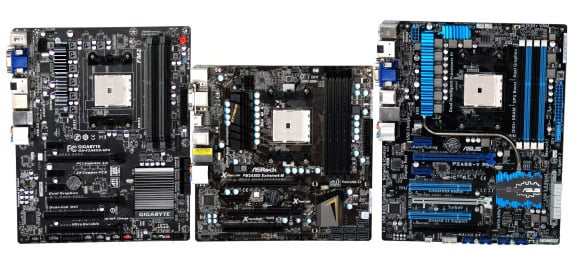AMD A85X Mobo Roundup: ASRock, Gigabyte, Asus
Introduction
We have had a few weeks with three A85X motherboards and AMD’s top of the line Trinity APU, the A10-5800K, which combines 4 unlocked Piledriver CPU cores (stock 3.8GHz, turbo 4.2GHz) with an integrated Radeon HD 7600D GPU with 384 Radeon Cores at 800MHz.
We’ve written several in-depth articles on AMD’s new Virgo platform--A85X chipset, FM2 socket and Trinity APUs--covering both the basics of the new A85X chipset, as well as CPU and overclocking performance. The FM2 socket is brand new for Trinity APUs and is not backwards compatible with FM1--sorry, Llano owners.
Now, the whole point of Trinity is that the integrated graphics are supposed to be robust enough to use without a discrete graphics card--after all, if you’re running discrete graphics (unless you’re trying AMD’s dual graphics), you don’t need an integrated GPU at all, and are probably better off with a regular Piledriver or Phenom chip and the 990FX platform. But as we’ve shown before, the integrated graphics on Trinity APUs are more than capable of replacing a budget discrete card, and can push out playable frame rates in plenty of games, even at relatively high resolutions. This makes Trinity a great choice for budget-conscious people who still want to game from time to time.
All three motherboards, of course, run the A85X chipset, the block diagram for which you can see above. The A85X chipset integrates nearly everything you could want in a motherboard, though some mobo manufacturers add their own features anyway--most frequently an additional USB 3.0 controller. With an A85X mobo, a Trinity APU, some RAM and a boot drive, you’ve already got a system going--one with plenty of SATA ports, PCIe slots (though only at 2.0 speeds), onboard sound, even an infrared header if you’re making an HTPC. It makes sense as a mainstream motherboard for applications (and users) that don’t require discrete graphics and audio.
Because A85X is designed for APUs with onboard graphics, you’d think the boards themselves would feel a bit, well, budget. Here you’d be mistaken: all three boards we tested look and feel like premium mobos, with robust overclocking support and plenty of high-end features. Despite this, none of the three motherboards--Asrock’s FM2A85X Extreme4-M, Asus F2A85V-Pro, and Gigabyte F2A85X-UP4--is over $140, and the cheapest, the Asrock board, is a mere $90. That’s a good price range for a board designed for APUs that top out at $130.
We’ve written several in-depth articles on AMD’s new Virgo platform--A85X chipset, FM2 socket and Trinity APUs--covering both the basics of the new A85X chipset, as well as CPU and overclocking performance. The FM2 socket is brand new for Trinity APUs and is not backwards compatible with FM1--sorry, Llano owners.
Now, the whole point of Trinity is that the integrated graphics are supposed to be robust enough to use without a discrete graphics card--after all, if you’re running discrete graphics (unless you’re trying AMD’s dual graphics), you don’t need an integrated GPU at all, and are probably better off with a regular Piledriver or Phenom chip and the 990FX platform. But as we’ve shown before, the integrated graphics on Trinity APUs are more than capable of replacing a budget discrete card, and can push out playable frame rates in plenty of games, even at relatively high resolutions. This makes Trinity a great choice for budget-conscious people who still want to game from time to time.

A85 FCH (Hudson D4) block diagram
All three motherboards, of course, run the A85X chipset, the block diagram for which you can see above. The A85X chipset integrates nearly everything you could want in a motherboard, though some mobo manufacturers add their own features anyway--most frequently an additional USB 3.0 controller. With an A85X mobo, a Trinity APU, some RAM and a boot drive, you’ve already got a system going--one with plenty of SATA ports, PCIe slots (though only at 2.0 speeds), onboard sound, even an infrared header if you’re making an HTPC. It makes sense as a mainstream motherboard for applications (and users) that don’t require discrete graphics and audio.
Because A85X is designed for APUs with onboard graphics, you’d think the boards themselves would feel a bit, well, budget. Here you’d be mistaken: all three boards we tested look and feel like premium mobos, with robust overclocking support and plenty of high-end features. Despite this, none of the three motherboards--Asrock’s FM2A85X Extreme4-M, Asus F2A85V-Pro, and Gigabyte F2A85X-UP4--is over $140, and the cheapest, the Asrock board, is a mere $90. That’s a good price range for a board designed for APUs that top out at $130.







